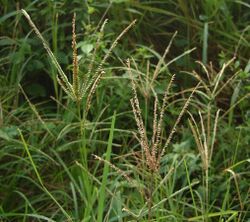Biology:Eleusine indica
| Eleusine indica | |
|---|---|

| |
| Scientific classification | |
| Kingdom: | Plantae |
| Clade: | Tracheophytes |
| Clade: | Angiosperms |
| Clade: | Monocots |
| Clade: | Commelinids |
| Order: | Poales |
| Family: | Poaceae |
| Genus: | Eleusine |
| Species: | E. indica
|
| Binomial name | |
| Eleusine indica (L.) Gaertn.
| |
Eleusine indica, the Indian goosegrass,[1] yard-grass,[2] goosegrass, wiregrass, or crowfootgrass, is a species of grass in the family Poaceae. It is a small annual grass distributed throughout the warmer areas of the world to about 50 degrees latitude. It is an invasive species in some areas.
Eleusine indica is closely related to Eleusine coracana (finger millet or African finger millet), and the diploid E. indica is likely an ancestor of the allotetraploid E. coracana.
Seeds of E. indica are edible and are sometimes used as a famine food, but yields are low. It is an important weed of cultivated crops, lawns, and golf courses. It thrives in disturbed areas with compacted soils in full sun. Both tillage and herbicides are used in its control. This low-growing grass is capable of setting seed even when closely mown. Some populations have evolved resistance to certain herbicides, including glyphosate.
Eleusine indica performs C4 photosynthesis and therefore can grow in hot climates and in the hotter months of the temperate zone. Its seeds germinate later in spring than most other temperate zone weeds, such as crabgrasses. Though usually considered an annual, it may survive for more than a year in climates not subject to frost.
References
- ↑ "Eleusine indica". Natural Resources Conservation Service PLANTS Database. USDA. https://plants.usda.gov/core/profile?symbol=ELIN3. Retrieved 18 January 2016.
- ↑ (xls) BSBI List 2007, Botanical Society of Britain and Ireland, https://bsbi.org/download/3542/, retrieved 2014-10-17
External links
- Jepson Manual Treatment
- Grass Manual Treatment
- Photo gallery
- weedipedia.net[yes|permanent dead link|dead link}}]
Wikidata ☰ Q1148930 entry
 |

